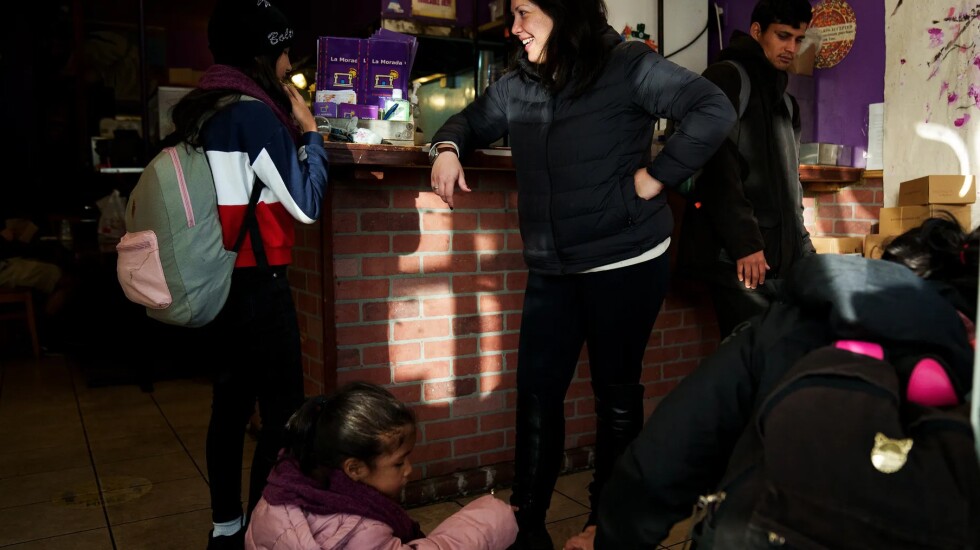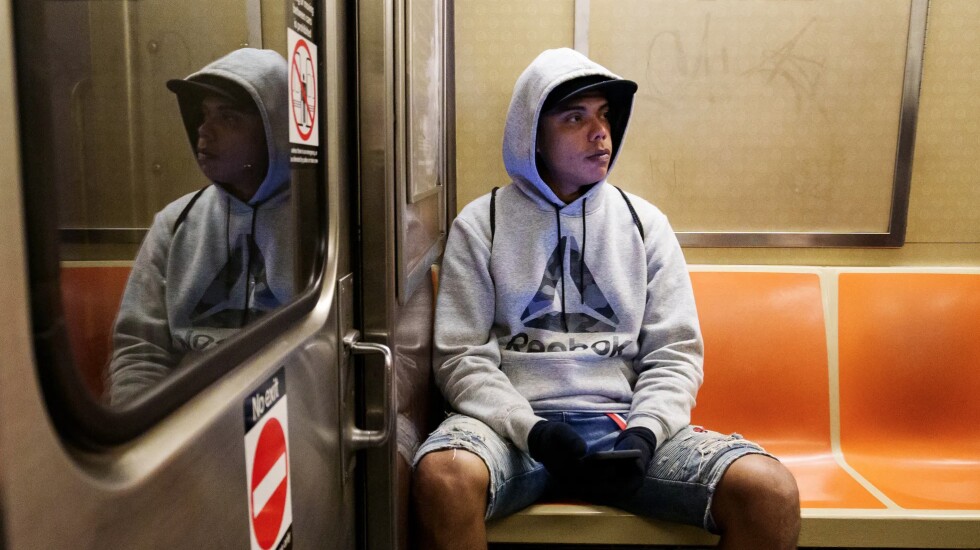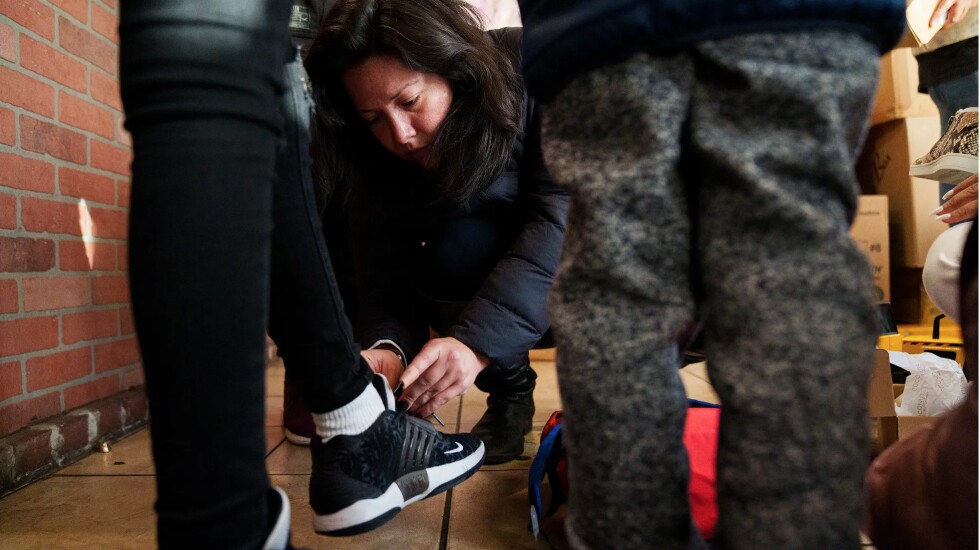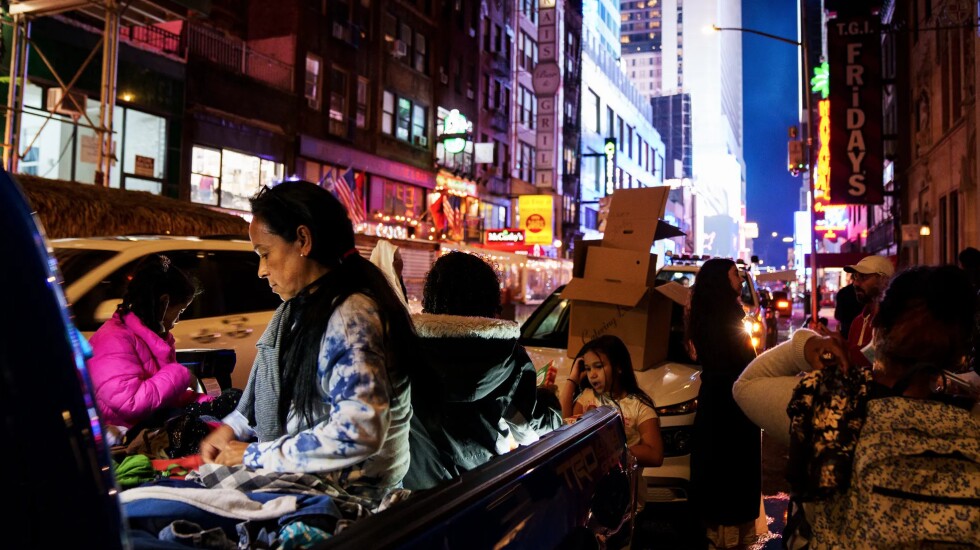
NEW YORK — Jhonny Ramos stepped into the 40-degree chill of midtown Manhattan with a heavy mix of concerns weighing on him.
He hadn’t found consistently paying jobs. With his immigration status up in the air, he didn’t have work authorization.
He needed to rush to the subway to get to a Western Union store in another borough. But the stitches from a recent appendectomy pulled at his skin, reminding him to slow down so they wouldn’t reopen.
Then, he needed to make it back to the shelter in time to avoid missing his next meal.
The next day, seven miles away in the south Bronx, Ariadna Phillips slammed shut the tailgate of her Kia Sorrento. Soon, she would be helping children find shoes that fit and their parents a place to sleep.
Her car was crammed with boxes of donated clothes, shoes, peanut-butter-and-jelly sandwiches, apples and loaves of bread. Every migrant she met, she added to several group chats on her phone on WhatsApp, chats that fill every morning with new questions about how to survive in a new city.
In New York, Ramos and Phillips are on opposite ends of an immigration pipeline that began with a bus ride on the border. For much of 2022, long-haul bus rides have been orchestrated by Republican governors as a kind of political theater: Divert asylum-seekers out of their states and into liberal coastal cities.

Instantly homeless
Many of the riders step onto the buses with the promise of a new life in a new city but step off instantly homeless.
Since June, more than 20,000 asylum-seekers have arrived in New York City on buses from Texas and Arizona. Other buses have ferried migrants to Chicago and Washington.
Officials in Texas and Florida say they are transporting only those migrants who choose to reach those destinations. But, after the buses roll away, asylum-seekers are left to navigate a foreign city without speaking the language, find a place to live with no relatives or sponsors to help them and feed themselves with no work lined up.
The result, in New York, means that thousands of migrants end up in the city’s homeless-shelter system, already strained with thousands of New Yorkers who had lost jobs and homes during the coronavirus pandemic and a decades-old housing crisis.
As of Oct. 24, more than 63,000 people crowded the city’s homeless shelters — an all-time high. Last month, Mayor Eric Adams declared a state of emergency to deal with the crisis and directed workers to erect large temporary tents to handle the overflow.
Murad Awawdeh, head of the New York Immigration Coalition, said it’s the largest influx of migrants to the city he’s seen in two decades working with asylum-seekers.
For volunteers like Phillips, assisting this new crush of homeless New Yorkers has become a second full-time job. Delivering food and supplies to spots across the city fills her weeknights.

Dream come true ‘more of a terror’
For Ramos, an asylum-seeker from Maracay, Venezuela, the bus ride to the East Coast hasn’t led to the American dream he envisioned.
In four months since arriving in New York City, he has been shuttled among three homeless shelters, fought off hunger and homelessness and struggled to make a few bucks doing odd jobs.
“I thought life here would be different, would be better,” Ramos said. “My dream has come true — the American dream. But lately it’s been more of a terror.”

Many of the thousands of migrants in newfound homelessness on the East Coast have struggled inside the New York shelter system, especially after what’s often a traumatic journey of leaving their country and traveling to the U.S.-Mexico border. In September, a migrant mom died of suicide while at a New York city shelter.
In Venezuela, Ramos’ father was a high-voltage worker for the country’s electrical corporation, known as Corpoelec. He worked with his father on job sites and also took shifts at a McDonald’s.
Ramos’s passion was baseball. He played third base and outfield for an amateur team. His dream was to follow in the footsteps of his cousin Johan, who was courted by the Cincinnati Reds. But a motorcycle accident when he was 22 ended Ramos’s ended any hopes he had of playing career.
Ramos was content to keep working with this dad and provide for his family. Then, thieves mugged and killed his father in his car as he drove home from work.
As the economy spiraled and the streets became ever more dangerous, Venezuela seemed like a dead end. Six years ago, he and his brother Fernando Ramos, 27, decided the only way to support their families was to go abroad. First, they lived in Colombia, making meager livings as carpenters, but, when the economy there also floundered, they decided to come to the United States. Friends had told them of plentiful job opportunities and how President Joe Biden was friendlier to immigrants than his predecessor, Ramos said. They decided to go to New York — which they had seen and admired in the Spider-Man movies. Earlier this year, they set out for the United States.
‘Nightmare’ journey
Ramos and his brother crossed the jungles of Colombia and Panama, spending six days stepping over bodies and sleeping in the bush in the Darién Pass, a notorious jungle trail connecting the two countries. He said women were sexually assaulted by gangs, and those who resisted were shot.
“It was horrible,” he said. “Like a nightmare.”
Out of the jungle and out of money, Ramos and his brother panhandled across Mexico, landing in and out of Mexican detention facilities, until reaching the U.S. border in July.
He said they left whatever they had — clothes, toiletries, anything else — to be able to move more quickly. They crossed the Rio Grande into Del Rio, Texas, on July 13, penniless but hopeful.
“It took us 27 days to get here to the United States,” Ramos said. “We got here skinny, dehydrated. But we made it. That was the important thing.”
Ramos and his brother were picked up and questioned by U.S. Border Patrol agents and released into the U.S. pending an immigration court hearing that could grant them asylum status and a work permit.
When officials offered them free bus rides to Washington, D.C., they accepted. Washington, they reasoned, was much closer to New York than South Texas.
Word had spread among migrants that Texas Gov. Greg Abbott was shuttling migrants away from the border as a political statement. The brothers took the bus rides anyway.
“At first, I was hesitant, I felt almost scared,” Ramos said. “But we had lost any fear years ago when we left our country … We decided to get on that bus and put ourselves in the hands of God.”
In New York, Ramos uses the free Wi-Fi hotspot at the subway station on 57th Street to send messages via WhatsApp on his smartphone to his mother and sister in Venezuela. He’s learned to navigate the subway lines and stops through the smartphone’s map app. If he has a few bucks for a subway pass, he’ll buy one. If he doesn’t — which is often — he patiently waits for a passenger to exit through the steel gate and slips past the turnstile.

Ramos is staying at the Park Savoy Hotel on West 58th Street, a nine-story hotel converted into a city homeless shelter, a block from Central Park and around the corner from One57, the 75-story tower where in 2014 Dell Technologies founder Michael Dell set a Manhattan record by buying a $100-million condo.
On this cold morning, Ramos needed to get to Brooklyn. He had been to a Western Union there earlier to send $50 of the little money he had made to his sister in Venezuela. But the money hadn’t arrived. Now, he needed to get to an office to persuade an agent to resend it.
He pulled up the train directions on his phone — take the “C” train 16 stops to the Franklin Avenue station — and checked his watch. He needed to be back at the shelter by noon for his free lunch — probably just a ham-and-cheese sandwich, but it’d be the only food he’d have until evening.
“I’ve missed so many meals,” Ramos said, heading to the subway station. “I can’t do it again.”
Bringing relief to migrants
Ariadna Phillips drove from her job at a Bronx middle school, where she teaches English as a new language and computer science, and went directly to La Morada Mexican restaurant on Willis Avenue in the South Bronx. She wolfed down a quick dinner of sopa de nopales (cactus soup) with rice and tortillas, then loaded boxes of donated clothes, shoes, peanut-butter-and-jelly sandwiches, apples and loaves of bread into her Sorrento.

A family of recently arrived Venezuelans wandered in to the restaurant and picked through the boxes stacked by the front, looking for shoes for their 9-year-old daughter. Phillips bent to one knee and helped the girl pull on a pair of pink high-tops.
“OK, in the United States, your shoe size is 41⁄2,” she told her.
The girl smiled shyly.

For years, La Morada has been the epicenter of migrant advocacy in the Bronx, and boxes of donated goods crowded the entrance. Since asylum-seekers from Texas and Arizona began arriving in the city, the restaurant, run by activist and organizer Yajaira Saavedra, has been at the forefront of helping them get clothes and food. Saavedra and Phillips have led that effort.
Each day, after working eight hours as a public school teacher, Phillips, 41, begins her second job — as a volunteer in the middle of New York City’s migrant crisis. She checks one of several WhatsApp chats on her phone for updates from migrants around the city, then loads up goods at La Morada and visits shelters where the migrants are staying, alerting them via WhatsApp of her arrival time.
After loading her car, Phillips decided which of the shelters she and other volunteers will visit first. Some nights, her WhatsApp channels chime repeatedly with news of migrants fleeing a shelter, and she and others scramble to find them alternative housing.
“They’ve been assaulted, they’ve been robbed, they’ve been kicked out of the shelter at all hours of the night or refused a bed,” Phillips said. “We do rapid response to intercept those people, especially if they’re facing a life threat at the particular shelter they’re at.”
The convoy pulled away from La Morada. Phillips checked her phone: 6:12 p.m. It was going to be a long night.

‘We’re your neighbors’
Phillips and the other volunteers pulled up at the homeless shelter — a hotel turned city shelter — a block east of Times Square around 6:40 p.m. Migrants streamed out of the hotel and began picking through sweaters, fleece blankets and snacks inside the boxes.
Down the street, jumbotron screens flashed ads for Sephora and Coca-Cola and “The Lion King” musical. Tourists swerved around the huddle of migrants on the sidewalk, filling outstretched shirts with peanut-butter-and-jelly sandwiches and apples.
“Hi, I’m Ariadna,” Phillips said in Spanish as she ushered more migrants to the back of a pickup holding clothes and loaves of bread. “We’re your neighbors.”
One woman needed antibiotics for a respiratory infection. Another said she didn’t feel safe at the shelter. Phillips jotted down their phone numbers and entered them into her WhatsApp chat. Anything you need, let us know there, she said.
“People said in New York there was all this opportunity,” said Angelica Barrades, an asylum-seeker from Caracas, Venezuela, who was staying at the shelter with her two daughters, 8 and 10. “But it’s been difficult. Very difficult.”
Phillips, born to a U.S. military dad and a mother of Mexican indigenous roots, grew up in Florida and settled into the Bronx after getting graduate degrees from Fordham University and Queens College. She has spent much of her adult life advocating for migrants and underserved communities.
During the coronavirus pandemic, as New York emerged as its U.S. epicenter, Phillips and her sister delivered food and supplies to first responders in the COVID-19 wards of hospitals.
Helping those who’ve helped him
Like other migrants assisted by the South Bronx Mutual Aid, Ramos has pledged to help wherever needed. On the night Phillips drove from one shelter to the next around Manhattan, Ramos joined her to help hand out donated goods or answer migrants’ questions.
Around 8 p.m., he and Phillips drove to the intake shelter on East 30th Street where, three months earlier, Ramos had spent his first night in New Yorkr. Asylum-seekers squatted on the curb outside and peered at their phones. Other, U.S.-born shelter residents mingled nearby.
Ramos pulled his hoody over his cap against the chill and handed out apples and loaves of bread as Phillips spoke with migrants.

One young couple from Venezuela had arrived just hours earlier. They wanted to stay together but were told the 30th Street shelter was only for men. Phillips got their information and, using her phone, registered them in the city system as a couple, then walked them insider to make sure they got in.
Ramos took questions from another couple and pointed them to Phillips.
After more than an hour, Phillips and Ramos packed what was left of the donated goods. It had been a good night.
Read more at USA Today.







